|
|
The suffolk Tree warden network
Alive in five ©
Contact Us
We will get back to you as soon as possible.
Please try again later.
As our climate changes, we need to make sure the saplings we plant grow into the trees and hedges of the future. Caring for your new planting over the first five years saves time, money and waste, and brings great satisfaction.
Help us keep as many new trees Alive in Five
© as you can!
This advice page complements our Alive in Five
© leaflet which you can
download as a pdf
1: Before you start – prepare the ground & plan
Improve sapling survival rates by
- Checking the soil conditions in your area
Clay soils can be challenging. In the winter they are easily waterlogged and this may create anaerobic conditions. In the summer, they dry and crack. Previous ‘cuts’ in the soil reopen and expose roots to the air. - Putting ‘the right tree in the right place’
Carefully choose species that are naturally suited to local soil conditions and native to the area. Check what’s growing wild around you to see what’s doing well. - Planting on plough pans
Clay soil with a long history of ploughing likely has a plough ‘pan’, which can negatively affect root development. Break this up by deep tine cultivation or use an augur. You may need specialist advice.
- Planting trees or woodland
- Remove weeds and grass by strimming or scraping the ground creating a clear area of 1m diameter where the tree will be planted. Grass and weeds compete with young trees for moisture, nutrients and light.
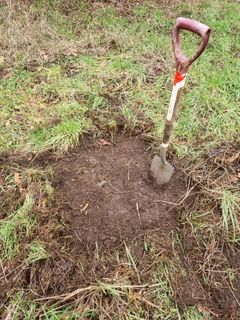
- Avoid weed-killers if you can. These can cause environmental damage, including destroying the fungi that are beneficial to tree growth.
Planting hedges - If planting a hedge, you should remove any weeds in a 1m strip along the new hedge line, ideally in (or before) October.
Now the land is ready, plan your planting Trees/Woodland - Go for a natural look by avoiding planting in straight lines if possible.
- Before you plant, mark out the location of each tree with stakes. Why not use coloured tapes to code what species goes where?
- Aim to have your shrub species (e.g. hazel, hawthorn, field maple) around the edges and mix a few among the trees - this helps create a transitional woodland edge. Great for wildlife and a wonderful windbreak.
- The distance between saplings will vary according to species, 2m is a good rule of thumb but 2.5m or even 3m if there’s space is OK.
Hedges - For single hedges, place saplings 30cm apart, and a standard tree every 10-15m within the hedgeline.
- For a thicker hedge, which is better and more traditional, plant a double row of saplings in a zig-zag . Allow 5 plants/m with at least 50cm between the staggered rows.
- Include standard trees every 10-15m. With less competition from other large trees, and added protection of the hedge, standard trees are more likely to become ancient trees. We are losing our ancient trees so take every opportunity to incorporate new ones in new hedges.
Hedgerows connecting existing or newly planted woodlands increase resilience and provide the maximum wildlife benefits.
2: Keep them safe – storage of trees before planting
If you can’t plant your saplings immediately, store them carefully until you are ready. Keep them away from direct sunlight, wind and frost. Protect the roots at all times and prevent drying out.
Bare-root or cell/container grown?
Bare-root saplings come direct from the ground. On lifting they often lose a portion of their roots and will have exposed roots when delivered.
Cell or container grown plants are sown in pots or containers of compost and come with soil and an intact root ball. Saplings that have been left growing in containers too long can be 'pot bound’ and may never develop proper root systems. Check and avoid.
Bare-root
- Healthy bare-root stock should have well-developed roots spreading in an even circle. Look for a 2-5cm diameter circle of roots. If all of the roots are growing on one side (‘hockey stick roots’), they are not well established. Check and avoid.
- Heel-in saplings you cannot plant immediately by digging a trench, putting in the bunched saplings at an angle with the stem supported. Generously cover the roots and base of the stem with soil and keep moist.
- If you need to wait until the next planting season after delivery, open out the bundles and place the saplings along the trench so soil gets to all the roots. Water throughout the spring and summer. Lift carefully next winter.
Cell grown
- Because cell grown plants will come with soil surrounding the roots, they don’t need heeling-in.
- Store them upright for a couple of weeks and keep moist but not waterlogged. Ideally under cover or in a shed or garage away from wind and frost.
3: Into the ground - when & how to plant
- Plant your saplings when they are dormant, from mid to end of November until (at the very latest) the end of February.
- But ideally, try to plant all your trees before the end of December because this allows the roots to settle.
- Don’t plant in frozen ground, wait for the thaw.
- Make sure you protect the buds and roots at all times when handling. Keep bare root saplings safe in a plastic sack when carrying them around the planting area.
- Pit planting
This is the best way to plant especially for larger trees or trees with bigger root systems. It is essential for cell/container grown trees.
- Dig a square hole, larger than the root system so the roots can spread out completely. Keep the root collar - the mark on the stem just above the root system - at ground level
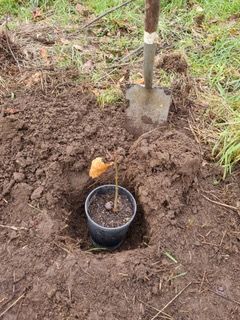
Backfill the hole, gently shaking and lifting the sapling helping settle the soil around the roots but don’t be too vigorous and pull the roots off.
Using your heel gently firm the soil when the hole is full making a good connection between the roots and the soil.
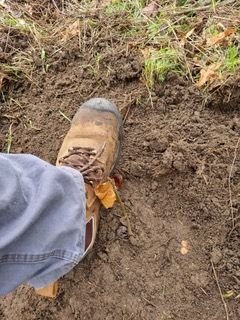
- Slit planting
You can slit plant hedge saplings of 60/80 cms or less in height. Push a spade into the soil to the depth of the roots; rock it back and forwards to widen the slit. Sweep the roots of the plant into the hole from one side without squashing them, then firm the soil around the plant with your heel. - Don’t do this with bigger plants. The roots won’t set in the ground to their full depth and rocking the spade backs and forwards compresses the soil and makes it harder to get a good connection with the roots.
- Protect with stakes and guards
Immediately protect your saplings from rabbits and deer. Use stakes & guards, or spirals & canes for hedges (unless you are using rabbit-proof fencing).
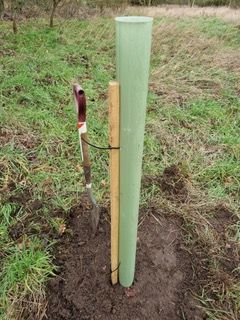
- Drive the stake into the ground, far enough away for the tree to be in the centre of the guard. It must also be deep enough to withstand strong winds.
- The top of the stake must be below the top of the guard, to avoid the tree being damaged by rubbing as it grows beyond the guard. Place the guard over the tree, taking care not to trap the stem behind the plastic ties. Pull the ties tight against the stake.
- Leave the guard raised approximately 1-2cm above the ground discourages small mammals from nesting. Nesting mice nibble the bark, damaging or even killing the young plant.
- When planting a hedgerow, the standard trees (i.e., species like oak, lime or hornbeam left to grow to full-sized trees) should be protected with 1.2m tall guards and stakes, rather than spirals/smaller tubes, so that they are protected from damage and deer.
- Make sure everyone knows where your new trees are! This should help avoid damage or accidental mowing. This is particularly important if you are planting in a community space with open access or where maintenance workers and gardeners operate. Maybe consider putting a sign up to highlight your new tree planting patch.
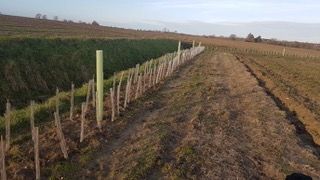
Trees in hedgerows are ecologically important and are a significant part of our landscape: they help to support a wide variety and diversity of species, especially of birds, bats and insects. Generally they should be planted every 10-15 metres along the hedge.
4: Mulch by March
Mulching is vital, and will save you time and money in the long run, so it is a wise investment.
It retains moisture, suppresses weeds and reduces the need for summer watering.
As our climate gets hotter and drier, mulching maximises the survival rates of your trees and hedgerows and prevents wasted effort and plants.
Plan to top up your mulch in March for the first 2 or 3 years after planting: it’s a false economy to skip mulching!
- How to mulch trees
Use a biodegradable mulch mat and then place additional mulch material on top. The mat suppresses weeds, mulch helps to lock in moisture. Mulch also helps regulate soil temperatures at the base of the tree to encourage root growth.
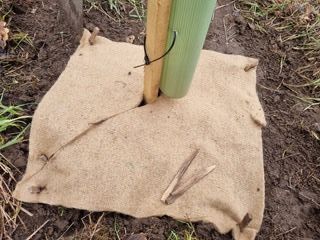
- Place the mat around the base of the tree guard and peg it down.
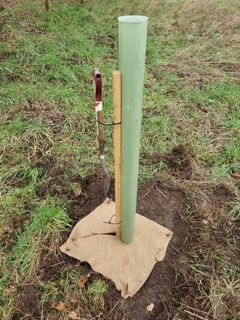
- Then apply a mulch (hardwood chip – ideally willow chip - or straw) in a 1m diameter circle around the tree, 10cm/4” deep.
- How to mulch hedges
- Mulch as above in a 1m wide strip across the full length of the hedge.
- Animals, especially rabbits, can disturb your mulch layer. Check and restore if so.

5: Alive in Five
Climate change means it is essential to check your young trees and hedges regularly to improve their survival. Ideally, you should check them once a month between May and September. Create a rota to help.
- Check list
- Are your mulch mats in place and do they need a top up of mulch material?
- Are your stakes and guards or spirals and canes still secure, especially after a storm or windy weather?
- Do you need to carry out a beating-up survey and replace dead trees? If so, mark the guards of trees which need replacing with a can of non-toxic spray paint. Use with a different colour each year. It is best to do this survey in August/September before leaves start falling. Try to achieve a minimum 90% overall success rate.
- Replace any large losses in hedges by 'gapping up’. Think about why the trees might be dying, and could you water more or choose a species more tolerant to the specific site?
- Look out for weeds such as thistles, docks and big clumps of grass growing in your tree guards. The best time to weed is early summer before seed-set, and in late summer when you can remove unwanted new plants. Left to overwinter, weeds compete with the young trees in the coming years.
- Check if ants have built ‘soil nests’ in the tree guard. Remove the guard and break away the soil before replacing.
- Plan to top up your mulch in March for the first 2 or 3 years.
Good luck – and enjoy your new trees and hedges!

© Suffolk Tree Warden Network. This advice has been prepared by Suffolk Tree Warden Network in collaboration with SCC and WT. Many thanks to Kelda McChesney for help with this project.
Resources
Tree Care Campaign - The Tree Council
Where to Plant - Plant Trees - Woodland Trust
wood-wise-hedgerows-and-hedgerow-trees.pdf (woodlandtrust.org.uk)
The structure of a hedge - People's Trust for Endangered Species (ptes.org)
How to help young trees survive prolonged hot dry weather - Forestry Commission (blog.gov.uk)

